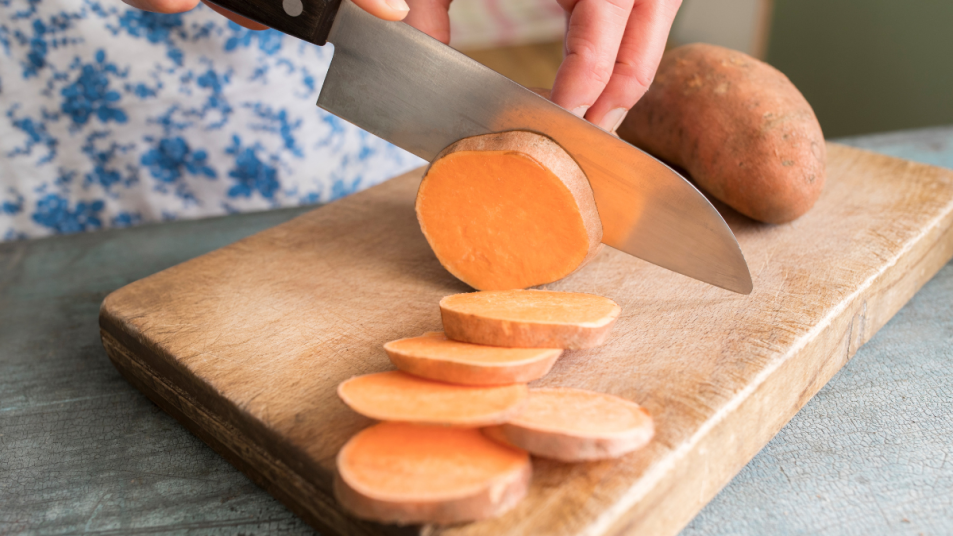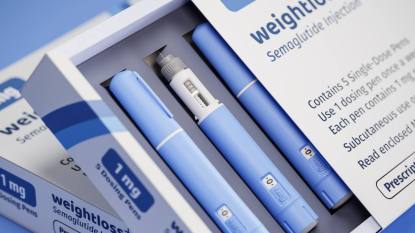What Is The Slow-Carb Diet? An MD + Dietitians Share Their Ultimate Slow-Carb Food List
Slow carbs are nutritious and delicious

The slow-carb diet is just one of the dozens of trendy diets people are talking up on online. You’ll find many versions of a slow carb diet food list and slow carb recipes everywhere. But is it just another fad diet? Doctors and dietitians say it can be a sustainable approach to eating that can help manage weight and improve overall health.
“The diet has a creative name, but the central idea really is that slower-carb foods are high in fiber, which helps with digestion, keeps you full for longer and ultimately is great for appetite control and weight management,” says Chris Mohr, a registered dietitian and co-founder of Mohr Results.
We asked the experts to explain the benefits of slow carbs and share their ultimate slow-carb diet food list to help you make the best choices for your health.
What is the slow-carb diet?
The slow-carb diet is based on the idea that not all carbs are created equal. This means you should include good (aka “slow”) carbs in your diet while keeping your overall carbohydrate intake relatively low. It breaks carbohydrate-rich foods into two categories:
Slow carbs
Also known as complex carbohydrates, these are mainly whole foods rich in nutrients. “Complex carbs retain their natural fiber, meaning slower digestion and a more gradual energy release,” says Raj Dasgupta, MD, a quadruple board-certified physician specializing in internal medicine. “Good examples include whole grains like brown rice, oats, legumes and vegetables,” says Dr. Dasgupta.
Fast carbs
Also known as simple or refined carbs, these foods are often processed and lack in fiber and other nutrients. This means they can spike your blood sugar and leave you hungry again soon after eating them.
“Fast-digesting carbs include sugars, refined starches and highly processed foods,” says Brittanie Volk, PhD, RD, and director of medical affairs at Virta Health. “Think sugary snacks and beverages like candies, cookies, pastries, sodas and fruit juices. Also, the refined white stuff — bread, rice, pasta and other shelf-stable items that are highly processed.”
Volk explains these fast carbs are lower in nutrient quality and are quickly digested and absorbed by the body. “They provide a burst of energy that only lasts for a short time and can lead to spikes in blood sugar, which is less than optimal for health in both the short- and long-term,” she says.
How did the slow-carb diet start?
This slow-carb diet evolved from the eating plan author Tim Ferris first outlined in his book The Four Hour Body back in 2010. It allowed animal protein, vegetables, legumes and fat, but prohibited some healthy foods like fruit. It also encouraged eating the same few meals on repeat and having one “cheat” day per week.
Experts think the elimination of fruit isn’t a smart approach to any diet. “A variety of fruit has a plethora of nutrients and fiber and can satisfy the desire for something sweet during the day,” says Mindy Haar, Ph.D., RDN, CDN, and assistant dean in the School of Health Professions at the New York Institute of Technology. “Cheat days” are also a bad idea, according to Haar. “With so many calorie-laden meals and snacks available, it’s possible to pack thousands of calories consumed in one day and offset weight lost during weekdays.”
That’s why experts recommend a modified version of the original slow-carb diet, replacing “fast carbs” with “slow carbs.” The most important foods to limit on a slow-carb plan are things like white flour pasta, white bread and sweets.
“Focusing on eating slow carbs can aid in weight loss,” Dr. Dasgupta says. “They help stabilize blood sugar levels, which can decrease insulin spikes and lessen the tendency to store fat. The high fiber content in these foods also helps people feel full for longer, so they hopefully consume less calories overall.”
Your slow-carb diet food list

We asked the experts to recommend their favorite slow carbs. You’ll want to eat these foods in addition to lean protein with most of your meals. And remember, no matter what diet or style of eating you follow, slow carbs can support achieving or maintaining a healthy weight.
1. Chickpeas
Also known as garbanzo beans, this all-star of the legume family is versatile. It’s the main ingredient in hummus and you can even use it to make a weight-loss friendly cookie dough dessert. “Chickpeas offer a good mix of protein and fiber,” says Mohr.
2. Quinoa should be on your slow carb diet food list
This pseudo-grain (it’s actually a seed) is the perfect slow-carb swap for white rice. “It provides all nine essential amino acids, making it a great protein source,” Mohr says. “It’s also high-fiber, helping keep you full and control blood sugar levels,” notes Dr. Dasgupta. Try combining it with black beans in this enchilada skillet recipe to get two great slow carbs in one meal.
3. Lentils
These are the quickest-cooking legumes, making them a convenient weeknight staple for anyone who wants to add more slow carbs to their life. “Lentils are high in protein and fiber, which help stabilize blood sugar and keep you satiated,” says Mohr.
4. Sweet potatoes
Move over, russet potatoes! The humble sweet potato is a slow carb packed with health benefits. “Sweet potatoes are high in fiber, potassium and other antioxidants,” says Mohr, making them a good slow-carb swap for white potatoes.
TRY THIS: Chef’s Foolproof Secret to Perfectly Crispy Roasted Sweet Potatoes Every Time
5. Greens belong on a slow carb diet food list
You’d be hard-pressed to find any doctor or dietitian who doesn’t recommend eating plenty of green vegetables. “Incorporating greens like broccoli, spinach and Brussels sprouts adds nutrients and fiber while keeping calories low.” says Dr. Dasgupta.
6. Beans
Beans and legumes are the ultimate slow carbs. One study showed that for every 20 grams of beans an older adult eats per day, their risk of death is reduced by 7-8%. “Black beans, pinto beans and kidney beans are filling and nutrient-rich,” says Dr. Dasgupta, who credits their combination of ample fiber and protein.
7. Oats
This breakfast staple can help reduce cholesterol. “Oats also help support digestion thanks to their soluble fiber, beta-glucan,” says Dr. Dasgupta. Beta-glucan helps improve blood pressure and other markers of metabolic syndrome, lowering the risk of heart disease and stroke.
8. Barley
An overlooked whole grain, barley is a good source of dietary fiber, vitamins like niacin and minerals like iron and manganese. Like oatmeal, it’s a good source of beta-glucan. Says Mohr: “It helps control blood sugar spikes and increases fullness.”
9. Brown rice
White rice is a fast carb, but there’s a very simple slow-carb swap: Brown rice. “It has much more fiber and nutrients than white rice,” Dr. Dasgupta says.
10. Berries definitely are on the slow carb diet food list
Don’t listen to anyone telling you to stop eating fruit to lose weight. “Berry fruits like blackberries, strawberries and blueberries, are real foods that are low in sugar and higher in fiber,” says Volk. They’re also packed with vitamins, antioxidants and other vital micronutrients. That makes them ideal for weight loss and good health.
TRY THIS: This 2-Ingredient Berry ‘Ice Cream’ Is the Only Dessert You’ll Ever Want to Eat Again
Slow-carb diet benefits

If the slow-carb diet appeals to you, there’s no reason not to try it—with modifications. You don’t need to exclude fruit or eat very low carb to get the benefits of slow carbs. And forget about cheat days. Experts recommend simply swapping fast carbs for slow carbs as often as you can, without being overly rigid.
“Slow carbs help you keep regular blood sugar levels, reduce feelings of hunger and minimize cravings,” says Dr. Dasgupta. It’s the reduced hunger and cravings that can lead to weight loss.
Slow-carb diet dangers
If you’re going to try a slow-carb diet, steer clear of the strictest versions that prohibit fruit and lead you to eating too much meat and saturated fat. “Unlimited amounts of animal protein is sometimes part of this diet,” Haar says. “Beef, pork, lamb and eggs are all sources of saturated fat. When eaten in excess, they can impact cardiovascular risk.”
“Paying too much attention to the types of food while ignoring portion sizes can also be a bad thing,” warns Volk. Dr. Dasgupta says women over 50, in particular, should be mindful about how much they’re eating on a slow-carb diet. “Metabolism slows with age,” he says. “Eating enough protein is also important to help preserve muscle mass, which tends to decrease as a person gets older.”
At the end of the day, the slow-carb diet is just another way to encourage people to eat the vegetables and whole grains you’ve always known are good for you. The secret ingredient in this diet is fiber. “Fiber in general is under-consumed. It’s known as a shortfall nutrient,” says Mohr. “So if calling a diet the slow-carb diet encourages higher consumption, that’s a very good thing.”
Keep reading for more on health and eating plans!
Nutrivore Diet for Better Health + Faster Weight Loss: Scientist’s Plan Works Without Deprivation
“I’m a Dietitian, and Here’s Why an Overly Restrictive Diet Can Backfire”
The Atlantic Diet May Be the Healthiest Diet Ever: What You Need to Know
This content is not a substitute for professional medical advice or diagnosis. Always consult your physician before pursuing any treatment plan.













